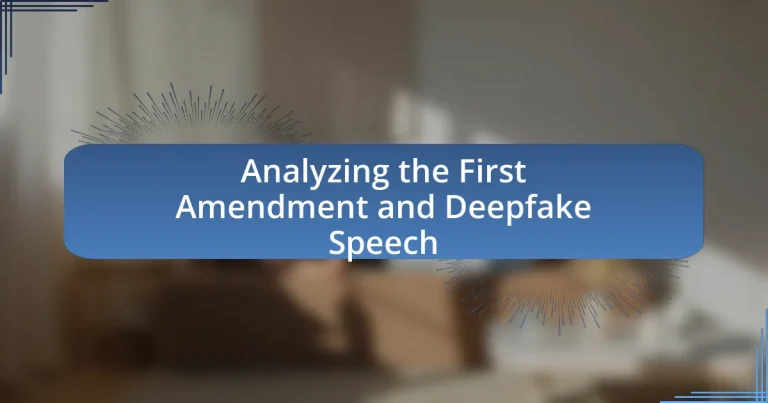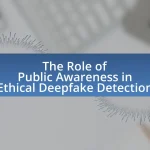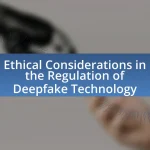The article examines the intersection of the First Amendment and deepfake speech, highlighting the constitutional protections afforded to free speech in the United States. It details how the First Amendment safeguards various forms of expression, including political, symbolic, and commercial speech, while also addressing the evolving interpretation of free speech in the context of emerging technologies like deepfakes. The discussion includes the ethical implications of deepfake technology, its potential to spread misinformation, and the legal challenges it poses regarding authenticity and public trust. Additionally, the article explores current legal frameworks, potential future regulations, and best practices for individuals and organizations to mitigate the risks associated with deepfake content.
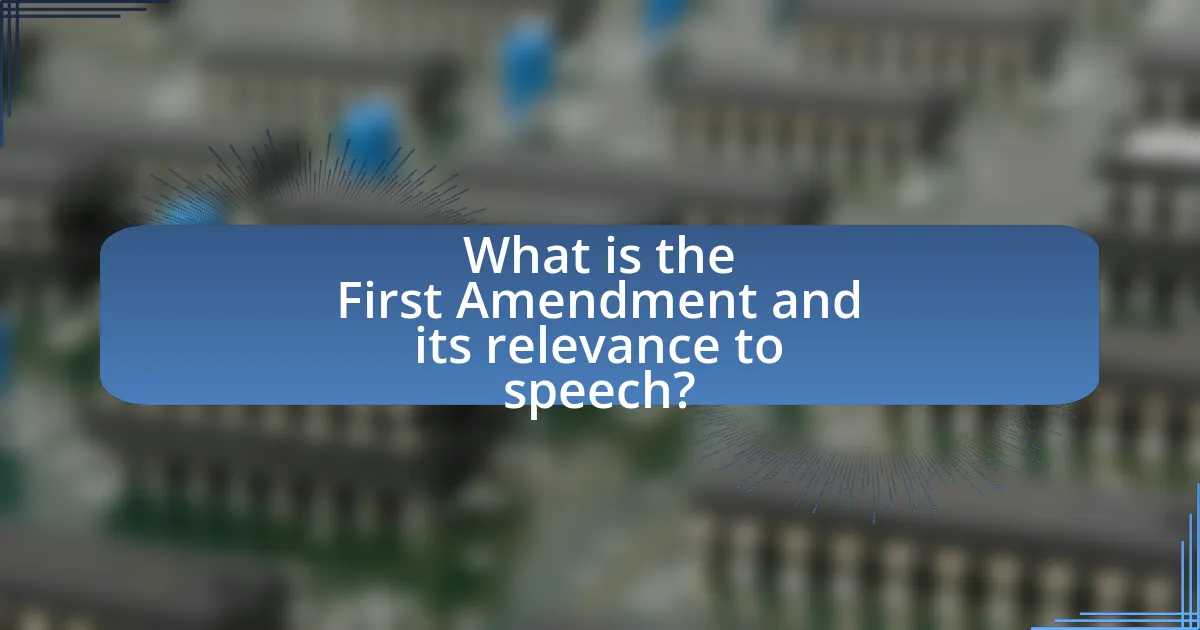
What is the First Amendment and its relevance to speech?
The First Amendment of the United States Constitution protects the freedoms of speech, religion, press, assembly, and petition. Its relevance to speech lies in its establishment of a fundamental right that allows individuals to express their thoughts and opinions without government interference. This amendment has been the basis for numerous Supreme Court cases, such as Tinker v. Des Moines Independent Community School District, which affirmed that students do not lose their right to free speech at school. The First Amendment’s protection of speech is crucial in fostering a democratic society where diverse viewpoints can be shared and debated.
How does the First Amendment protect free speech?
The First Amendment protects free speech by prohibiting Congress from making laws that infringe upon the freedom of expression. This constitutional provision ensures that individuals can express their thoughts, opinions, and beliefs without government interference. The protection extends to various forms of communication, including spoken, written, and symbolic speech, as established in landmark Supreme Court cases such as Tinker v. Des Moines Independent Community School District (1969), which affirmed that students do not “shed their constitutional rights to freedom of speech or expression at the schoolhouse gate.” Additionally, the First Amendment safeguards against prior restraint, meaning the government cannot prevent speech before it occurs, reinforcing the principle that free expression is fundamental to democracy.
What are the key components of the First Amendment?
The key components of the First Amendment are the freedoms of speech, religion, press, assembly, and petition. These components collectively protect individuals from government interference in expressing their beliefs, sharing information, gathering peacefully, and seeking redress of grievances. The First Amendment was ratified in 1791 as part of the Bill of Rights, establishing foundational rights that are essential to democratic governance and individual liberty in the United States.
How has the interpretation of free speech evolved over time?
The interpretation of free speech has evolved significantly from its inception in the First Amendment to contemporary discussions, particularly regarding digital content like deepfakes. Initially, free speech was primarily understood as a protection against government censorship, focusing on political speech and dissent, as established in landmark cases such as Schenck v. United States (1919), which introduced the “clear and present danger” test. Over time, the scope expanded to include symbolic speech, commercial speech, and hate speech, as seen in cases like Tinker v. Des Moines Independent Community School District (1969) and Virginia v. Black (2003).
In recent years, the rise of digital platforms and technologies, including deepfakes, has prompted new legal and ethical considerations regarding the limits of free speech. Courts are now grappling with how to balance free expression with the potential for harm caused by misinformation and manipulated media. This ongoing evolution reflects a dynamic legal landscape that adapts to societal changes and technological advancements.
What types of speech are protected under the First Amendment?
The First Amendment protects several types of speech, including political speech, symbolic speech, commercial speech, and hate speech, as long as it does not incite violence or constitute true threats. Political speech is highly protected because it is essential for democracy, as established in landmark cases like Brandenburg v. Ohio, which affirmed that speech advocating illegal action is protected unless it incites imminent lawless action. Symbolic speech, such as flag burning, is also protected under the First Amendment, as ruled in Texas v. Johnson. Commercial speech, which includes advertising, receives some protection but is subject to regulation to prevent misleading information. Hate speech is protected unless it directly incites violence or poses a true threat, as clarified in cases like R.A.V. v. City of St. Paul.
What constitutes protected speech versus unprotected speech?
Protected speech includes expressions that are safeguarded by the First Amendment, such as political speech, artistic expression, and commercial speech, while unprotected speech encompasses categories like obscenity, defamation, incitement to violence, and true threats. The U.S. Supreme Court has established that speech is protected unless it falls into these unprotected categories, as seen in cases like Miller v. California, which defined obscenity, and Brandenburg v. Ohio, which clarified the limits of incitement.
How do courts determine the limits of free speech?
Courts determine the limits of free speech by applying a balancing test that weighs individual rights against societal interests. This process often involves interpreting the First Amendment, which protects free speech, while also considering established exceptions such as incitement to violence, obscenity, and defamation. For instance, in the landmark case Brandenburg v. Ohio (1969), the Supreme Court ruled that speech advocating illegal action is protected unless it incites imminent lawless action. Additionally, courts analyze the context and potential harm of the speech, as seen in cases involving hate speech or false statements. This framework ensures that while free speech is broadly protected, it is not absolute and can be limited when it poses a clear and present danger to public safety or order.
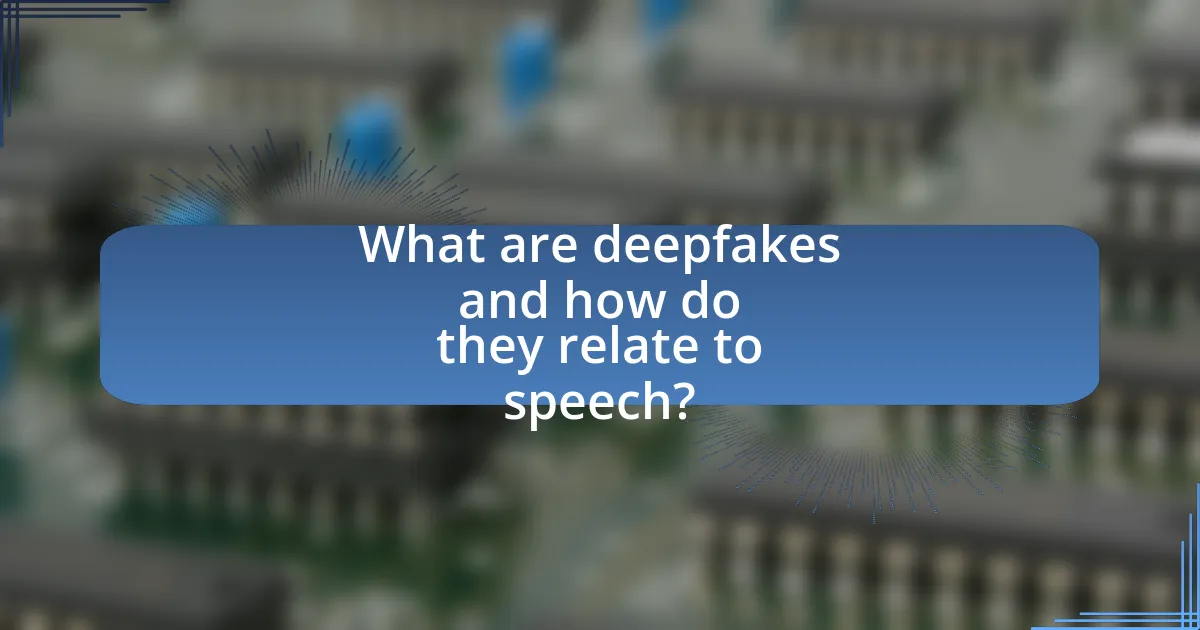
What are deepfakes and how do they relate to speech?
Deepfakes are synthetic media created using artificial intelligence techniques, primarily deep learning, to manipulate or generate visual and audio content that appears authentic. They relate to speech by enabling the creation of realistic audio clips that can mimic a person’s voice, allowing for the fabrication of spoken statements that the individual never actually made. This capability raises significant concerns regarding misinformation, consent, and the potential for harm, as deepfake technology can be used to create misleading narratives or impersonate individuals in a manner that may violate their rights under the First Amendment.
What technologies are used to create deepfakes?
Deepfakes are primarily created using artificial intelligence technologies, specifically deep learning techniques such as Generative Adversarial Networks (GANs). GANs consist of two neural networks, a generator and a discriminator, that work together to produce realistic images or videos by learning from large datasets of existing media. This technology enables the synthesis of highly convincing fake content by manipulating facial expressions, voice, and other attributes. The effectiveness of deepfakes is supported by advancements in machine learning algorithms and the availability of extensive training data, which enhance the realism of the generated outputs.
How do deepfake algorithms function?
Deepfake algorithms function primarily through the use of deep learning techniques, particularly Generative Adversarial Networks (GANs). GANs consist of two neural networks: a generator that creates synthetic images or videos and a discriminator that evaluates their authenticity. The generator improves its output by learning from the feedback provided by the discriminator, which is trained to distinguish between real and fake content. This iterative process continues until the generator produces highly realistic deepfakes that can convincingly mimic the appearance and voice of real individuals. Research has shown that GANs can achieve remarkable results, with some models generating images that are indistinguishable from real photographs, as evidenced by studies published in reputable journals.
What are the ethical implications of deepfake technology?
The ethical implications of deepfake technology include the potential for misinformation, invasion of privacy, and manipulation of public perception. Misinformation arises as deepfakes can create realistic but false representations of individuals, leading to the spread of false narratives, as evidenced by instances where deepfakes have been used to create fake news videos that mislead viewers. Invasion of privacy occurs when individuals’ likenesses are used without consent, often resulting in reputational harm, as seen in cases where celebrities have been targeted with non-consensual deepfake pornography. Additionally, the manipulation of public perception can undermine trust in media and democratic processes, as deepfakes can be weaponized in political campaigns to distort reality, exemplified by the use of deepfake videos in election interference. These ethical concerns highlight the need for regulatory frameworks to address the misuse of deepfake technology.
Why are deepfakes considered a form of speech?
Deepfakes are considered a form of speech because they involve the creation and dissemination of content that conveys a message or idea, similar to traditional forms of expression protected under the First Amendment. The U.S. legal framework recognizes that speech encompasses various mediums, including visual and audio representations, which deepfakes utilize to simulate real individuals saying or doing things they did not actually say or do. This classification aligns with the Supreme Court’s interpretation of speech, which includes not only spoken or written words but also expressive conduct that communicates a viewpoint. Therefore, deepfakes, as a method of expression, fall under the umbrella of speech protected by the First Amendment, despite the potential for misuse or harm.
How do deepfakes challenge traditional notions of authenticity in speech?
Deepfakes challenge traditional notions of authenticity in speech by creating highly realistic but fabricated audio and video content that can mislead audiences about the speaker’s true intentions or statements. This technology undermines the reliability of visual and auditory evidence, which has historically been used to validate authenticity in communication. For instance, a study by the University of California, Berkeley, found that deepfake technology can produce videos that are indistinguishable from real footage, raising concerns about misinformation and trust in media. As a result, the ability to discern genuine speech from manipulated content becomes increasingly difficult, complicating legal and ethical discussions surrounding free speech and the First Amendment.
What legal precedents exist regarding deepfake speech?
Legal precedents regarding deepfake speech are still developing, but several cases and laws have begun to shape the landscape. For instance, the case of “United States v. McCoy” in 2020 highlighted the potential for deepfakes to be used in criminal activities, leading to discussions about the applicability of existing fraud laws. Additionally, California’s AB 730, enacted in 2019, specifically addresses the malicious use of deepfakes in the context of election-related speech, establishing a legal framework for addressing deceptive practices. These examples illustrate the emerging legal recognition of deepfake speech and its implications for First Amendment rights, as courts and legislatures grapple with balancing free expression against potential harm.
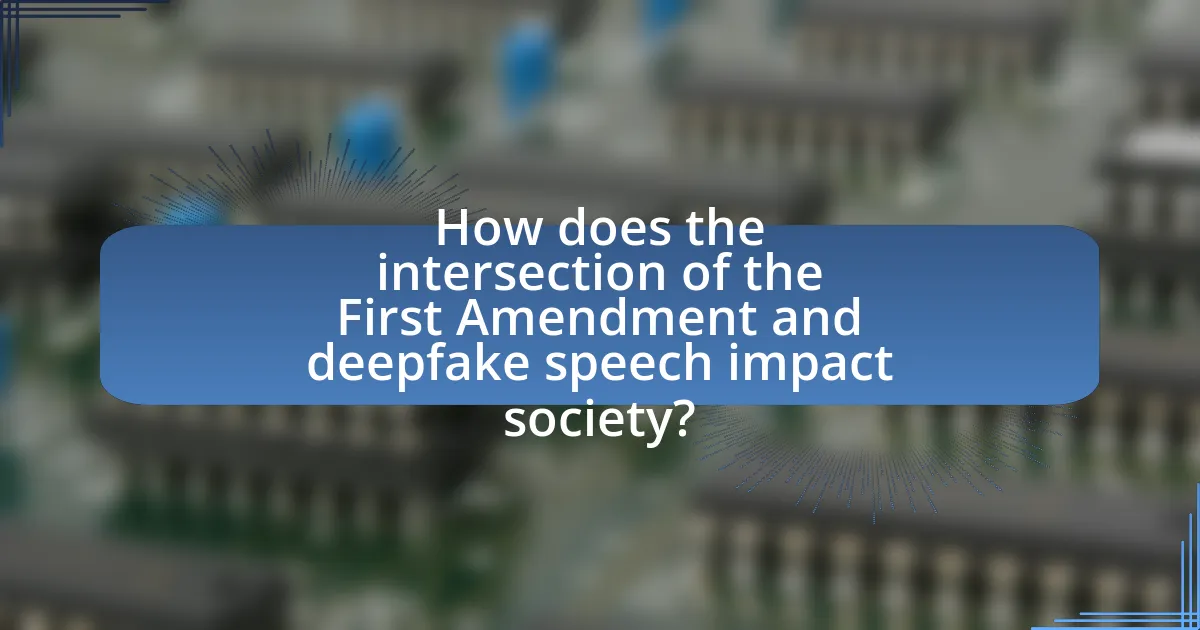
How does the intersection of the First Amendment and deepfake speech impact society?
The intersection of the First Amendment and deepfake speech significantly impacts society by raising complex issues regarding free expression and misinformation. The First Amendment protects freedom of speech, which includes various forms of expression, but deepfakes can distort reality and spread false information, potentially leading to harm or public deception. For instance, a study by the Brookings Institution highlights that deepfake technology can be used to create misleading videos that may influence public opinion or elections, thereby undermining democratic processes. This duality creates a societal challenge where the protection of free speech must be balanced against the potential for deepfake content to cause real-world consequences, such as reputational damage or erosion of trust in media.
What are the potential consequences of deepfake speech on public discourse?
Deepfake speech can significantly undermine public discourse by eroding trust in media and information sources. The proliferation of deepfake technology allows for the creation of highly convincing yet fabricated audio and video content, which can mislead audiences and distort reality. A study by the University of California, Berkeley, found that 85% of participants could not distinguish between real and deepfake videos, highlighting the potential for misinformation to spread rapidly. This erosion of trust can lead to increased polarization, as individuals may become more skeptical of legitimate sources, ultimately harming democratic processes and informed decision-making.
How can deepfakes influence political opinions and elections?
Deepfakes can significantly influence political opinions and elections by creating misleading or fabricated content that appears authentic. This manipulation can sway public perception, as individuals may believe false narratives presented through deepfake videos or audio, leading to misinformation. For instance, a study by the University of California, Berkeley, found that exposure to deepfake content can alter viewers’ beliefs about political figures, demonstrating the potential for deepfakes to impact voter behavior and election outcomes.
What role do deepfakes play in misinformation and disinformation campaigns?
Deepfakes play a significant role in misinformation and disinformation campaigns by enabling the creation of highly realistic but fabricated audio and video content that can mislead audiences. These manipulated media can distort reality, making it appear as though individuals are saying or doing things they never did, which can be exploited to influence public opinion, manipulate political narratives, or damage reputations. For instance, a study by the University of California, Berkeley, found that deepfakes can reduce the perceived credibility of genuine news sources, thereby exacerbating the spread of false information. This capability to create convincing falsehoods poses a serious challenge to information integrity and democratic discourse.
What legal challenges arise from deepfake speech in relation to the First Amendment?
Deepfake speech presents significant legal challenges under the First Amendment, primarily concerning the balance between free speech rights and the potential for harm caused by misinformation. The First Amendment protects freedom of expression, but deepfakes can lead to defamation, fraud, and incitement to violence, raising questions about the limits of protected speech. Courts have historically ruled that certain types of speech, such as false statements that cause harm, are not protected. For instance, the Supreme Court has established that speech that incites imminent lawless action or constitutes true threats is not covered by the First Amendment. Therefore, the legal landscape surrounding deepfake speech is complex, as it must navigate the tension between protecting free expression and addressing the risks associated with deceptive content.
How are courts currently addressing deepfake-related cases?
Courts are currently addressing deepfake-related cases by applying existing laws on defamation, fraud, and intellectual property to evaluate the legality and implications of deepfake content. For instance, in cases where deepfakes are used to harm an individual’s reputation or mislead consumers, courts have utilized defamation statutes to hold creators accountable. Additionally, some jurisdictions are exploring new legislation specifically targeting deepfakes, reflecting the growing concern over their potential misuse. Recent rulings have also emphasized the importance of context in determining whether deepfake content constitutes protected speech under the First Amendment, balancing free expression with the need to prevent harm.
What future legal frameworks could be developed to manage deepfake speech?
Future legal frameworks to manage deepfake speech could include specific regulations that classify deepfake content as a distinct category of speech, subject to scrutiny under laws addressing misinformation and fraud. These frameworks may establish clear definitions of deepfake technology, outline the responsibilities of creators and distributors, and impose penalties for malicious use that causes harm, such as defamation or incitement to violence.
For instance, existing laws like the California Deepfake Law, which prohibits the use of deepfakes to harm others, could serve as a model for broader national legislation. Additionally, frameworks could incorporate requirements for labeling deepfake content, similar to regulations in advertising, to ensure transparency and protect consumers from deception. Such measures would aim to balance the protection of free speech under the First Amendment with the need to prevent harm and misinformation in the digital landscape.
What best practices can individuals and organizations adopt regarding deepfake speech?
Individuals and organizations can adopt several best practices regarding deepfake speech to mitigate risks and enhance accountability. First, they should implement robust verification processes to assess the authenticity of audio and video content, utilizing tools like digital watermarks and AI detection software. Research indicates that deepfake detection technology has improved significantly, with some models achieving over 90% accuracy in identifying manipulated media. Second, educating stakeholders about the implications of deepfake technology is crucial; awareness programs can help individuals recognize potential misinformation and its consequences. Third, establishing clear policies and guidelines for the ethical use of AI-generated content can promote responsible practices and discourage malicious use. Finally, fostering collaboration with technology companies and regulatory bodies can lead to the development of standards and frameworks that address the challenges posed by deepfake speech.
How can media literacy help combat the effects of deepfake speech?
Media literacy can help combat the effects of deepfake speech by equipping individuals with the skills to critically analyze and evaluate media content. This critical analysis enables people to discern between authentic and manipulated information, reducing the likelihood of being misled by deepfakes. Research indicates that media literacy programs can significantly improve individuals’ ability to identify misinformation; for instance, a study by the Stanford History Education Group found that students who received media literacy training were better at evaluating the credibility of online sources. By fostering skepticism and analytical thinking, media literacy serves as a vital tool in mitigating the impact of deepfake speech on public perception and discourse.
What tools are available to detect and mitigate deepfake content?
Tools available to detect and mitigate deepfake content include Deepware Scanner, Sensity AI, and Microsoft Video Authenticator. Deepware Scanner utilizes machine learning algorithms to analyze videos for signs of manipulation, while Sensity AI employs a combination of computer vision and deep learning to identify deepfake media. Microsoft Video Authenticator assesses images and videos to provide a confidence score regarding their authenticity. These tools are supported by advancements in AI and machine learning, which enhance their effectiveness in identifying altered content.
